Mycosis is an easy disease to treat but difficult to treat. This is due to many factors. Pathogenic microorganisms quickly adapt to changing conditions, get used to the active ingredients of medicines. They are capable of being on different surfaces for a long time. They multiply rapidly, capturing more and more new areas. They literally penetrate the horny plates, penetrating deeper and deeper. The treatment of nail fungus should be carried out in a comprehensive manner, in accordance with all the rules. Otherwise, you may face a situation where the symptoms start to pass, but everything quickly returns to its original position.
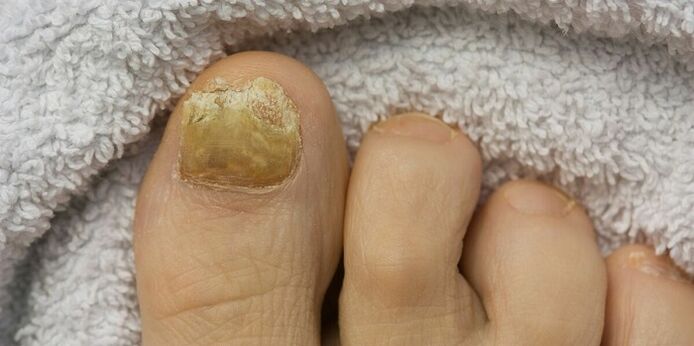
How can you get onychomycosis?
Most often, the infection, according to statistics, occurs as follows:
- Personal contact with a person suffering from a fungus;
- Personal items: washing cloths, towels, shoes;
- When visiting saunas, beaches, showers, sports clubs;
- With a pedicure performed with instruments that have not been disinfected.
Infection can occur anywhere people walk barefoot. If a person with mycosis has walked across the floor, the scales of his skin remain on the surface. If they get into healthy nails, a pathological process will begin. A similar route of infection occurs when you use other people’s personal belongings. Fungal microorganisms grow particularly actively in warm places with high humidity. That is why they usually accumulate in saunas, baths, spas.
Even if a fungus has taken the nails, it does not mean the onset of the disease. The body's defenses are sufficient to fight infection. However, there are factors under the influence of which the fungus enters and spreads more actively. If they are present, the risks of detecting this disease in itself increase many times over. Consider these factors:
- Wounds and cuts on the feet, microcracks typical of dry skin - all of these are gateways for infection;
- A weakened immune system;
- Taking antibiotics that change the acidity of the feet;
- Poor hygiene
- Sweating of the feet;
- Metabolic problems;
- Diabetes;
- AIDS;
- Mbipesha.
Factors that cause the development of the disease can be:
- Lack of personal slippers when visiting public places;
- Using someone else's shoes;
- Use of narrow synthetic materials;
- Ignoring the need for regular bathroom disinfection;
- Lack of proper foot hygiene.
Based on these observations, it is easy to derive methods for preventing mycosis.
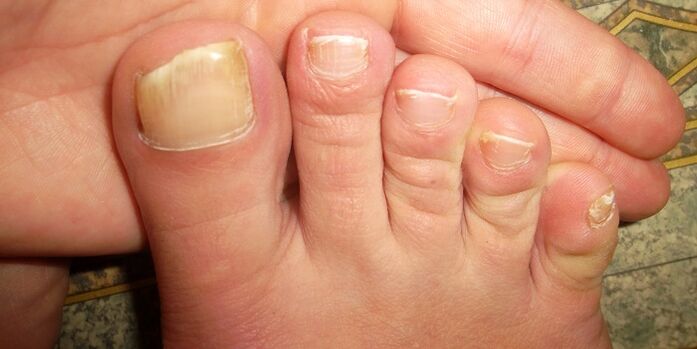
Symptoms
Signs of the disease become apparent only when the fungus is already in a moderate stage. However, it is possible to diagnose the disease in the first stage. To do this, you just need to carefully monitor the condition of the nails. The following symptoms should be reported:
- Peeling of the feet;
- The appearance of white spots on the nails;
- Slight itching;
- Dry feet.
With these signs, it is best to see a doctor. They are not specific, and therefore one disease can be easily confused with another. The symptoms of the later stages will be much more pronounced:
- The nail loses its natural luster, becomes turbid;
- The tile takes on unnatural shades: yellow, green, blue;
- The nail begins to crumble, stratify, become much more brittle;
- The plate begins to detach from the nail bed. Before that, free spaces open between him and the bed;
- The structure of the nails is changing. It looks thick. The nail may bend, growth pathologies are observed;
- The disease spreads to the skin. An inflammatory process develops on them, manifested in the release of pus, redness;
- The space between the toes peels off, cracks appear;
- Itching and burning intensify;
- An unpleasant odor appears.
In the more advanced stages, the fungus severely destroys not only the nails but also the skin. Abscesses may appear. All this causes severe discomfort, interferes with a normal lifestyle.
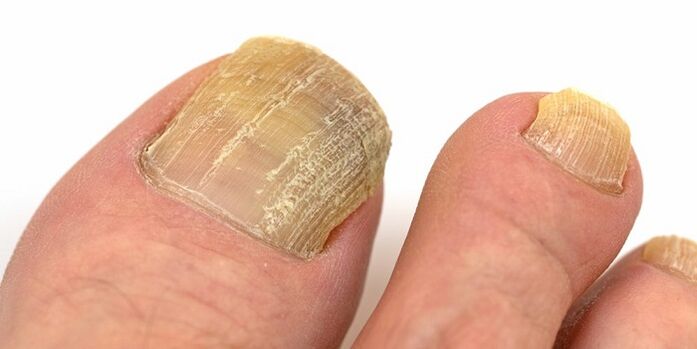
Is mycosis dangerous if left untreated?
An untreated disease includes the following problems:
- Occurrence of infectious complications;
- Occurrence of severe allergic reactions;
- Causing exacerbations of various diseases, including diabetes;
- Defeat of internal organs by fungal microorganisms.
In the later stages, the disease is very unpleasant. There is a discharge of pus, cracks appear. It hurts to walk. A strong odor arises. All of this makes it difficult to lead a normal life. In addition, pathogens enter the bloodstream and can affect the entire body. This is extremely dangerous and fraught with disability or even death.
Treatment depending on the stage of the disease
Nail fungus has several stages, depending on the extent of the lesion. The methods of therapy will be 90% phase dependent. Consider the features of treatment depending on the stages of disease development:
- Phase 1.Good reviews can be found on the medical solution. It works very well in the early stages of the disease. The solution is used to treat diseased nails twice a day. Before processing, it is recommended to take a hot bath for the feet, trim the nails and process them with a file. The cost of the solution is approximately 500 rubles. The advantage of the solution in the form of the solution is its immediate absorption, rapid action;
- Phase 2The free part of the nail is removed with scissors or a nail file. A healing solution is applied to the cavity as well as to the entire surface of the plate. It is advisable to start taking pills. The treatment will last approximately 6 months;
- Phase 3In this case, the lesion affects not only the plaque but also the root, nail bed and nearby skin. Treatment is carried out with drugs of systemic action. It is imperative to observe a doctor, as you can not get rid of an advanced stage without the help of a specialist.
The success of nail fungus treatment is determined by the regeneration of a healthy plaque, in which there are no signs of damage.
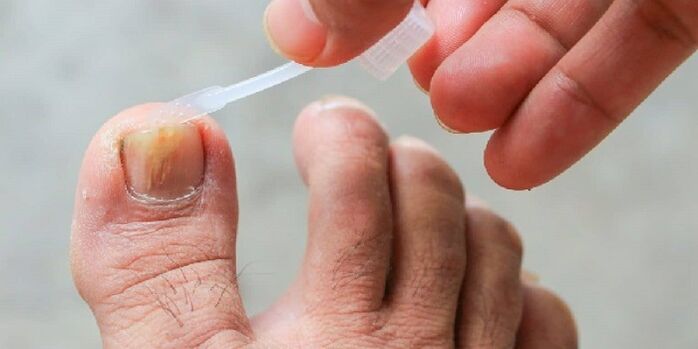
Basics of mycosis treatment
How to cure toenail fungus? Therapy is performed using two sets of funds:
- Local preparations.Used in the first and second stages of the disease. Can be combined with systemic medications. This category includes varnishes, solutions, oils, gels;
- Systemic drugs.They are antifungals. These can be tablets, capsules. They stop the spread of disease, destroy pathogenic microorganisms. They have an accumulating effect. That is, the active ingredients of the medicine remain in the ingredients even after the end of the therapy. This prevents relapse.
It is best to treat nail fungus early. This is due to the fact that, in this case, only local preparations can be used. Tablets are very effective, but they are also toxic, they have many contraindications and side effects. It is forbidden to take pregnant women and children.
Use of medicinal varnishes
Varnishes are excellent in the early stages of nail fungus. They have the following advantages:
- You do not need to apply the product every day. Twice a week is enough;
- The varnish dries almost immediately;
- The tool creates a film on the surface of the nail that does not allow additional bacteria and infections inside;
- The varnish is transparent, and therefore not noticeable on the nails.
Course characteristics depend on the specific varnish. Their significant disadvantage is their considerable cost.
Antifungal tablets
Antifungal tablets will be required if the fungus has spread to more than 1/3 of the nail. A specialist should prescribe a remedy for nail fungus, as the choice depends on the type of microorganisms that caused the disease.
Almost all tablets have free counterparts. The cost of medicines is different.

Laser therapy
In some cases, nail fungus does not respond to medication. In this case, you can use laser therapy. The following advantages should be emphasized:
- Without pain;
- Effective destruction of fungal microorganisms;
- There is no harm to healthy tissues;
- The possibility of curing a disease at a severe stage in only 4-6 procedures.
It is advisable to supplement laser surgery with systemic medications as well as vitamin complexes aimed at increasing the body's defenses.
Nail removal
Toenail removal is usually indicated in the advanced stages of toenail fungus. Using this method on a relatively healthy dish is not recommended. Removal has the following advantages:
- Painless (removal occurs due to maximum plaque softening);
- Stopping the spread of pathological processes;
- Better penetration of drugs into the focus of the disease.
Removal can be done at home. For this, there are special preparations. Removal is performed due to the urea content in the products. Also in the composition there are auxiliary ingredients that stop the reproduction of fungi and have an antiseptic effect: stearic acid, tea tree oil.
Before use, the feet are steamed in a bath with a tablespoon of baking soda. They should be wiped dry. Then a plaster is glued to the integrity near the nail. The product should not be put in contact with the skin, as this will cause burns. The composition is applied to the nail with a thick layer, and then sealed with a plaster. After 4 days, the patch is removed. If the nail does not fall, the event can be repeated.
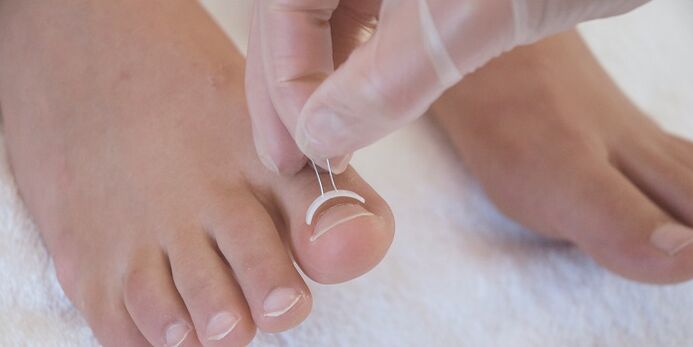
Traditional methods of treatment
It makes sense to apply popular techniques in the early stages. They have an additional effect. However, it should be borne in mind that these funds do not replace local medicines. Consider the most common popular methods for nail fungus:
- Apple cider vinegar.Vinegar is mixed with water in a one-to-one ratio. The feet are placed in a hot bath for 15-20 minutes. The procedure is performed daily. After that, the feet should be completely dry. The effect can be seen after 2 weeks. If it is not there, the product should be replaced with another;
- Tea tree oil.Apply to affected nails in a pure form three times a day. One point is needed for each tile. There are contraindications: childhood and pregnancy;
- Fresh celandine.The plant should be minced. The liquid is squeezed out of the gravel. This can be done with gauze. A glass of juice is combined with a glass of 70% alcohol. The solution is introduced throughout the day. Before processing, the legs are steamed. The infusion is then applied to the plates. Processing is carried out 3-4 times a day. The course is 10-12 days;
- Jod.Apply one drop of iodine daily to the affected area. Do not forget to trim the growing nail. If there is a burning sensation, you should stop the procedure. This effect indicates tissue burning;
- Tea mushrooms.Compresses can be made from it. For this, a piece of mushroom is placed on the nail. The finger is wrapped in cellophane and bandage. Then put on cotton socks. The procedure is performed at night. In the morning, the compress is removed, the foot is washed under warm water, the dead areas are removed.
What is the best treatment for toenail fungus? Popular recipes will not work for this. They can only be used as an aid. However, the main therapy should be taking the pills and medications of the day.
Witness
People who have had nail fungus note the effectiveness of the medicinal solution, which is suitable for use. However, it should be borne in mind that the tool should be used regularly for a long time. Without this, mycosis will reappear immediately.
Celandine is also effective. People notice that the noticeable effect can be noticed already after 3 weeks of use. The structure of the nail changes, the signs of damage disappear. However, this is only important for the early stages of the disease.
You may also see negative reviews. They usually warn against misuse of legal remedies. For example, patients, when using iodine and acetic acid, received severe burns. Therefore, the use of these funds must be carried out in accordance with security measures. In particular, the recommended dosage should not be exceeded. If a burning sensation occurs, this indicates the onset of a burning sensation. Do not believe articles that claim that pain is a sign of healing. Usually this is a sign of serious processes that can leave behind complications that are bigger than after a fungus.
Additional measures
Additional measures are needed in order to speed up treatment and also prevent relapses. Let us consider the main ones:
- The patient's skin particles remain in socks and shoes. If a person is completely healed, interacting with them, you can become infected again. Therefore, socks should be soaked for 5 minutes. All fungal microorganisms will be destroyed in boiling water. The shoes are treated with special compositions that can be found in pharmacies;
- Vitamin complexes should be taken in order to stimulate the immune system;
- All funds are used regularly, during the course described. Otherwise, the treatment will be completely useless.
An attentive attitude to all recommendations is the key to a speedy cure.
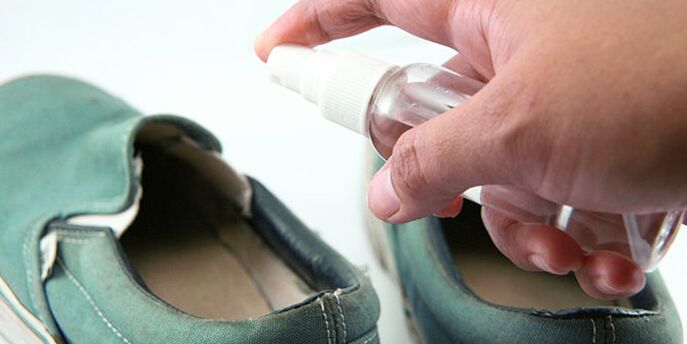
Preventive measures
To prevent re-infection with mycosis, preventive measures are applied:
- Before visiting baths, saunas and other public institutions, it is recommended to lubricate your nails with antifungal varnishes;
- You should not wear someone else’s shoes;
- You can perform hot foot baths once a week, where sea salt and soda are added;
- It is advisable to exclude sweets from the diet;
- Sweaty feet should be avoided.
Once a week, after a recent treatment, you can use a local antifungal or similar medicine. They are applied to all nails. Even if the infection reappears, it will quickly stop.
It is more difficult to protect yourself from illness when living with a sick person. In this case, regular disinfection of the bathroom and all surfaces in the house is important. The patient should store and wash his belongings separately from other clothes. Families can use local mycosis remedies once a week for prophylaxis.
Mycosis is difficult to treat. His therapy should be taken very seriously. At the first sign, it is advisable to see a doctor. He gets an itch from the affected area. After that, you can determine which microorganisms caused the disease. Based on this information, medications are prescribed. Individual factors also play a role in the choice of medication. For example, if a woman is pregnant, the pills are rarely prescribed. This is due to the fact that they penetrate into the bloodstream and can harm the fetus. Typically, nail removal is used in combination with topical treatments.
























